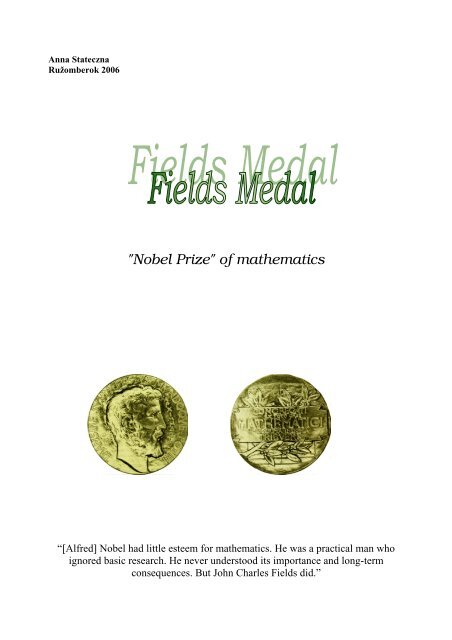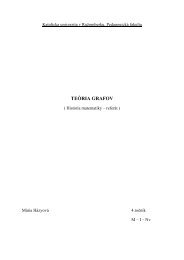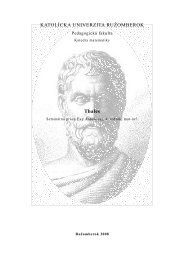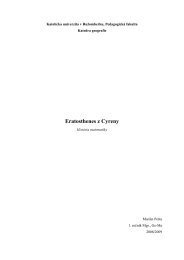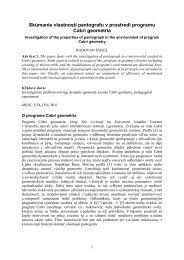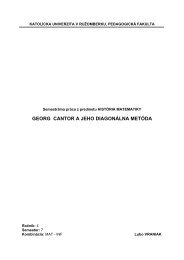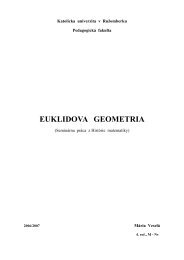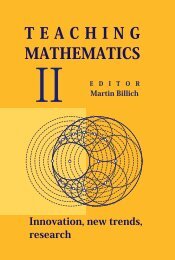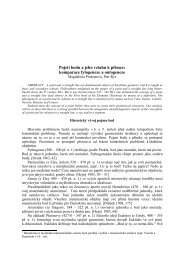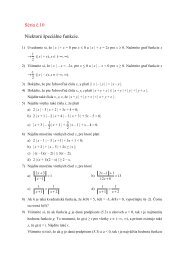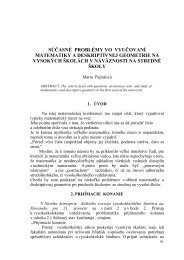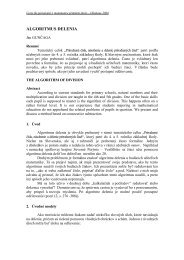"Nobel Prize" of mathematics
"Nobel Prize" of mathematics
"Nobel Prize" of mathematics
Create successful ePaper yourself
Turn your PDF publications into a flip-book with our unique Google optimized e-Paper software.
Table <strong>of</strong> contentsIntroduction _________________________________________________________________ 3How many winners <strong>of</strong> the <strong>Nobel</strong> Prize for <strong>mathematics</strong> can you name? 3Why did <strong>Nobel</strong> choose these fields? 3Condition for future prizewinners 3History <strong>of</strong> the Fields Medal _____________________________________________________ 4Why <strong>Nobel</strong> chose not to establish a prize in <strong>mathematics</strong>? 4After Fields death 5John Charles Fields (1863-1932)_________________________________________________ 5Bibliography 6Field’s letter _________________________________________________________________ 7The Fields Medal – description __________________________________________________ 8Obverse 8Reverse 9The Fields Medal in popular culture ______________________________________________ 9Fields Medal Prizewinners _____________________________________________________ 10Fields Medal Winners 2002 ____________________________________________________ 11
The Fields Medal, <strong>of</strong>ficially known as International Medal for Outstanding Discoveries inMathematics, is the highest scientific award for mathematicians not over forty years <strong>of</strong> age ateach International Congress <strong>of</strong> the International Mathematical Union (therefore once every fouryears), since 1936 and regularly since 1950 at the initiative <strong>of</strong> the Canadian mathematician JohnCharles Fields. The purpose is to give recognition and support to young mathematicalresearchers having already made important contributions.IntroductionHow many winners <strong>of</strong> the <strong>Nobel</strong> Prize for <strong>mathematics</strong> can you name?None, right? But cheer up. You can’t think <strong>of</strong> one because there is no <strong>Nobel</strong> Prize for<strong>mathematics</strong>. The top award for mathematicians is the Fields Medal, which happens to bear thename <strong>of</strong> a Canadian.In 1896 the Swedish inventor Alfred <strong>Nobel</strong> died rich and famous. His will provided theestablishment <strong>of</strong> a prize fund. Starting in 1901 the annual interest was yearly awarded for themost important contributions to physics, chemistry, physiology or medicine, literature, andpeace. The economics prize appeared later. The Central Bank <strong>of</strong> Sweden founded it in 1968 tocommemorate its 300th anniversary.Why did <strong>Nobel</strong> choose these fields?The inventor <strong>of</strong> dynamite loved chemistry and physics. Literature was his great passion; inspite <strong>of</strong> a busy life, he found time to read and write fiction. Medicine and peace were naturalchoices for the benefit <strong>of</strong> humankind. But what about <strong>mathematics</strong>?Whatever the reason, <strong>Nobel</strong> had little esteem for <strong>mathematics</strong>. He was a practical man whoignored basic research. He never understood its importance and long-term consequences.Condition for future prizewinnersThe Fields Medal Committee is chosenby the Executive Committee <strong>of</strong> theInternational Mathematical Union and isnormally chaired by the IMU President. It isasked to choose at least two, with a strongpreference for four, Fields Medallists, and to
Field’s letterThis is the original letter by Fields creating. It has been written during the few monthsbefore his death. Notice that no mention is made about the 40 year-old limit, and that the medalshouldn't bear anybody's name.It is proposed to found two gold medals to be awarded at successive InternationalMathematical Congress for outstanding achievements in <strong>mathematics</strong>. Because <strong>of</strong> themultiplicity <strong>of</strong> the branches <strong>of</strong> <strong>mathematics</strong> and taking into account the fact that the intervalbetween such congresses is four years it is felt that at least two medals should be available. Theawards would be open to the whole world and would be made by an International Committee.The fund for the founding <strong>of</strong> the medals is constituted by balance left over after financingthe Toronto congress held in 1924. This must be held in trust by the Government or by somebody authorized by government to hold and invest such funds. It would seem that a dignifiedmethod for handling the matter and one which in this changing world should most nearly securepermanency would be for the Canadian Government to take over the fund and appoint as hiscustodian say the Prime Minister <strong>of</strong> the Dominion or the Prime Minister in association with theMinister <strong>of</strong> Finance. The medals would be struck at the Mint in Ottawa and the duty <strong>of</strong> thecustodian would be simply to hand over the medals at the proper time to the accreditedInternational Committee.As things are at present a practical course <strong>of</strong> procedure would seem to be for the ExecutiveCommittee <strong>of</strong> a Congress to appoint a small international committee authorized to add to itsnumber and call into consultation other mathematicians as it might deem expedient. TheCommittee would be expected to decide on the ones to whom the awards should be made thirtymonths in advance <strong>of</strong> the following Congress. Its decisions would be communicated to thePresident and Secretary <strong>of</strong> the Organizing Committee <strong>of</strong> the Congress, this Committee havingthe duty <strong>of</strong> communicating to the Prime Minister <strong>of</strong> Canada the names <strong>of</strong> the recipients in orderthat the medal might be prepared in time and forwarded to the president <strong>of</strong> the OrganizingCommittee. Immediately on the appointment <strong>of</strong> the Executive Committee <strong>of</strong> the Congress themedals would be handed over to its President. The presentation <strong>of</strong> the medals would constitutea special feature at some general meeting <strong>of</strong> the Congress.In the above arrangements the role <strong>of</strong> the Organizing Committee might be taken over bythe Executive <strong>of</strong> the International Mathematical Union at some time in the future when thatorganization has been generally accepted.In coming to its decision the hands <strong>of</strong> the IC should be left as free as possible. It would beunderstood, however, that in making the awards while it was in recognition <strong>of</strong> work alreadydone it was at the same time intended to be an encouragement for further achievement on thepart <strong>of</strong> the recipients and a stimulus to renewed effort on the part <strong>of</strong> others.In commenting on the work <strong>of</strong> the medalists it might be well to be conservative in one'sstatements to avoid envidious comparisons explicit or implied. The Committee might easematters by saying they have decided to make the awards along certain lines not alone because<strong>of</strong> the outstanding character <strong>of</strong> the achievement but also with a view to encouraging furtherdevelopment along these lines. In this connection the Committee might say that they had electedto select subjects in Analysis, in Geometry, in the Theory <strong>of</strong> Groups, in the Theory <strong>of</strong> Numbersetc. as the case might be. When the Committee had come to an agreement in this sense theclaims for recognition <strong>of</strong> work done along the special lines in question could be considered indetail by two smaller groups or subcommittees with specialized qualifications who would haveauthority to take into consultation or add to the subcommittees other mathematicians <strong>of</strong>specialized knowledge.With regard to the medals themselves, I might say that they should each contain at least200 dollars worth <strong>of</strong> gold and be <strong>of</strong> a fair size, probably 7.5 centimeters in diameter. Because<strong>of</strong> the international character the language to be employed it would seem should be Latin orGreek? The design has still to be definitely determined. It will have to be decided on by artists
in consultation with mathematicians. The suggestions made in the preceding are tentative andopen to consideration on the part <strong>of</strong> mathematicians.It is not contemplated to make an award until 1936 at the Congress following that atZurich during which an international Medal Committee should be named.The above programme means a new departure in the matter <strong>of</strong> international scientificcooperation and is likely to be the precursor <strong>of</strong> moves along like lines in other sciences than<strong>mathematics</strong>.One would hear again emphasized the fact that the medals should be <strong>of</strong> a character aspurely international and impersonal as possible. There should not be attached to them in anyway the name <strong>of</strong> any country, institution or person.Perhaps provision could be made as soon as possible after the appointment <strong>of</strong> theExecutive <strong>of</strong> the Zurich Congress for the consideration by it <strong>of</strong> the subject <strong>of</strong> the medals, and theappointment without undue delay <strong>of</strong> a Committee and the awards <strong>of</strong> the medals to be made inconnection with the Congress <strong>of</strong> 1936.Suggestions with regard to the design <strong>of</strong> the medals will be welcome.(Signed) J.C. Fields Research Pr<strong>of</strong>essor <strong>of</strong> Mathematics University <strong>of</strong> TorontoThe Fields Medal – descriptionThe medal, struck by the Royal Canadian Mint, is a gold-plated cast, 25 centimetres indiameter. Designed in 1932 by the Canadian sculptor Robert Tait McKenzie.McKenzie had his own impressions <strong>of</strong> the greatest mathematician <strong>of</strong> antiquity. In 1932 hewrote to Synge: “I feel a certain amount <strong>of</strong> complacency in having at last given to themathematical world a version <strong>of</strong> Archimedes that is not decrepit, bald-headed and myopic, butwhich has the fine presence and assured bearing <strong>of</strong> the man who defied the power <strong>of</strong> Rome.”ObverseThe head represents Archimedes facing Canadian sculptor who designed the medal.right. (1)In the field is the word The correct date would read:ΑΡΧΙΜΗ∆ΟΥΣ in Greek capitals"MCMXXXIII" or 1933.and (2)the artist's monogram anddate RTM, MCNXXXIII. (3) TheThe second letter M has tobe substituted for the falseinscription reads: TRANSIREN. (3) The Latin inscriptionSUUM PECTUS MUNDOQUEfrom the Roman poetPOTIRI.The inscriptions mean (1) "<strong>of</strong>Manilius surrounding hisimage may be translated “toArchimedes", namely the face <strong>of</strong>pass beyond yourArchimedes. (2) R(obert) T(ait) understanding and make yourself master <strong>of</strong>M(cKenzie), that is the name <strong>of</strong> the the universe”. The phrase comes from
Manilius’s Astronomica 4.392 from thefirst century A.D. The complete passage isThe object <strong>of</strong> your quest is God; you areseeking to scale the skies and though bornbeneath the rule <strong>of</strong> fate, to gain knowledge<strong>of</strong> that fate; you are seeking to pass beyondyour understanding and make yourselfmaster <strong>of</strong> the universe.The inscription on the tablet reads:CONGREGATIEX TOTO ORBEMATHEMATICIOB SCRIPTAINSIGNIATRIBUEREIt means:"ThemathematiciansReversehaving congregated from the whole worldawarded (this medal) because <strong>of</strong> outstandingwritings". The verb form "tribuere" (the first"e" is a long vowel) is a short form <strong>of</strong>"tribuerunt". Behind the inscription is alaurel branch, and a diagram <strong>of</strong> a spherecontained in a cylinder from an engravingthought to have been on Archimedes’ tomb.The Fields Medal inpopular cultureIn the 1997 film Good Will Hunting,fictional MIT (Massachusetts Institute <strong>of</strong>Technology) pr<strong>of</strong>essor Gerald Lambeau(played by Stellan Skarsgård) is described ashaving been awarded a Fields Medal for hiswork in combinatorial <strong>mathematics</strong>.
Fields Medal PrizewinnersSince 1936, 44 mathematicians have received the Fields Medal. The first medals <strong>of</strong> the 21stcentury were awarded in the year 2002 in China.• 2002: Laurent Lafforgue (France) , Vladimir Voevodsky (Russia/US)• 1998: Richard Ewen Borcherds (GB), William Timothy Gowers (GB), MaximKontsevich (Russia), Curtis T. McMullen (US), and a silver plate was given to AndrewWiles (GB)• 1994: Efim Isakovich Zelmanov (Russia;39 years), Pierre-Louis Lions (France;38), JeanBourgain (Belgium;40), Jean-Christophe Yoccoz (France;36)• 1990: Vladimir Drinfeld (USSR;36), Vaughan Frederick Randal Jones (New Zealand;38),Shigefumi Mori (Japan;39), Edward Witten (US;38)• 1986: Simon Donaldson (GB;27), Gerd Faltings (West Germany;32), Michael Freedman(US;35)• 1982: Alain Connes (France;35) , William Thurston (US;35), Shing-Tung Yau(China;33)• 1978: Pierre Deligne (Belgium;33), Charles Fefferman (US;29), Grigory Margulis(USSR;32), Daniel Quillen (US;38)• 1974: Enrico Bombieri (Italy;33), David Mumford (US;37)• 1970: Alan Baker (GB;31), Heisuke Hironaka (Japan;39), Sergei Petrovich Novikov(USSR;32), John Griggs Thompson (GB;37)• 1966: Michael Atiyah (GB;37), Paul Joseph Cohen (US;32), Alexander Grothendieck(France;38), Stephen Smale (US;36)• 1962: Lars Hörmander (Sweden;31), John Milnor (US;31)• 1958: Klaus Roth (GB;32), Rene Thom (France;35)• 1954: Kunihiko Kodaira (Japan;39), Jean-Pierre Serre (France;27)• 1950: Laurent Schwartz (France;35), Atle Selberg (Norway;33)• 1936: Lars Ahlfors (Finland, 29), Jesse Douglas (US;39)
Fields Medal Winners 2002Laurent LafforgueInstitut des Hautes ÉtudesScientifiques, FranceVladimir VoevodskyInstitute for Advanced Study


